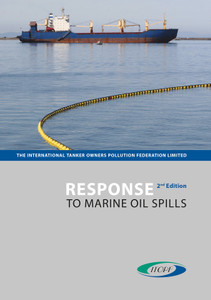
This book covers the basics of crude oil tanker operations, including cargo transfer, venting, purging, pump theory, and inert gas and crude oil washing systems.
The topics covered in this book range from the basics of crude oil chemistry to the economics of the oil market. Fundamentals of cargo operations, such as calculating cargo quantity, are explained in both theory and practice. This ensures that the basics of operating crude oil tankers and their related activities are not neglected; readers will be equipped with the required knowledge to perform operations fully and correctly.
The book is supported by photographs taken on board a new build VLCC.
This textbook covers everything from the basics of crude oil chemistry to the economics of the oil market. As I read the book, I was so impressed that I must provide some highlights of its contents, to illustrate why I believe this book to be the best on the market.
Loss control and cargo measurements, since they are often taken by shoreside metering and verified by independent inspectors, may be easily overlooked in day to day cargo operations. Nevertheless, modern measurement systems may fail or have errors. Ships might often be blamed for losses that result from these errors unless measurement theories are understood and put into practice. Volumes loaded, transported and discharged must be carefully measured and monitored by ships so that differences in volumes and contaminations can be identified, resolved and notices of protest appropriately issued. ‘Measurement of Cargo Quantity’ and ‘Calculating Cargo Quantity’ each spell out theories, recommended processes and commercial implications of good measurement techniques aboard ships, therefore ensuring sound cargo custody practices and saving loss claims against the ship.
‘Loading Rates and Venting’ explains the critical relationship between ship and shore. Priceless rules of thumb include ‘…a tank filling rate of 5 cm (2 inches) per minute is considered to be a reasonable loading rate for topping off …’. Implementing this can only be done if terminal staff are given long enough notice time to slow down shoreside pumping systems. Venting systems on tankers protect ships’ tanks from over pressurisation that can be generated at flow rates generated by high volume terminal pumps. Ships’ officers must understand tank vents, ensure that they are operating and properly set and monitor them as carefully as tank volumes. Explanations of different venting systems, vapor recovery apparatus and other details remind ships’ officers of the importance of this equipment.
Loading and discharging cargo are critical operations, during which an accident might compromise the safety of the crew, the ship or the environment. Well thought out plans, carefully reviewed and implemented, that contain standing instructions, specific instructions and emergency procedures go a long way to successful cargo operations. They also provide maximum flexibility to commercial operators, allowing changes to load or discharge sequences generated by unforeseen circumstances. Finally, requirements for adequate rest periods for officers and crews are not only mandated by STCW, but also make good practical sense and ensure safe operations.
First time cargo officers are often timid about raising loading rates during the early stages of loading and reducing loading rates to top off at the end of loading operations. ‘Old timers’ can become complacent and make assumptions. ‘The Loading Operation’ is full of guidelines and reminders of procedures and checks necessary during initial loading, full rate loading, topping off and completion to ensure a safe and successful outcome. Armed with such knowledge that aft loading tanks will fill faster when the vessel is trimmed by the stern and that, as a rule of thumb, the time taken for hydraulic valves to close is about the same as the diameter of the valve in millimetres (a 550 mm valve will take about 55 seconds to close) will enhance confidence. Easily accessed checklists and suggested procedures will remind cargo officers that successful cargo operations are a matter of good planning, well managed operations and good old common sense. Ample warnings built into this chapter will also remind experienced officers that complacency can lead to disaster.
Success often depends on a theoretical understanding blended with practical experience. Crude tanker pumping systems transfer large volumes quickly; tanker officers’ success with these systems will be enhanced through basic understanding of pump theory. ‘Cargo Discharge Operation’ becomes straightforward once the reader is armed with critical pump theories. The impact of discharge time on charter party performance can have a major impact on voyage profitability. Good records, well kept logbooks, carefully monitored, maintained and logged discharge pressure and well implemented plans that maximise bulk pumping time, while keeping low volume stripping to a minimum, will ensure that any demurrage claims are valid and give charterers little ammunition to refute them.
Inert gas systems are complicated, requiring attention to safety, monitoring, and carefully coordinated operation so that they protect the crew and the ship without endangering either. ‘Inert Gas’ shows how these systems operate with theoretical and practical illustrations and explanations.
Properly performed crude oil washing (COW) benefits both the ship and the cargo owners. Hazards include ignition, pollution and chemical reactions that can quickly end a life or a career. Clues and suggestions will help readers to use COW successfully and profitably.
Ballast water on tankers is considered so critical that MARPOL, SOLAS and Loadline Conventions all regulate it. The author shares his rich experience with personal insights to handle ballast water safely, in a pollution free manner and in various classes of crude oil tankers. For example, properly maintained and operated ODMEs, required under MARPOL, are complex instruments that may provide crucial evidence to exonerate (or implicate) a tanker with an oil pollution. ‘Ballasting, Deballasting and Oil Content Discharge Control’ is loaded with nuggets of information and suggestions, pointing out mandatory requirements for handling ballast water.
Cautious owners with well run tankers remain the core of the world’s tanker industry. Effectively maintained tankers ensure safe operations, good cargo custody, charter party compliance and satisfied charterers, therefore a profitable revenue stream to owners. None of these can be achieved unless the hazardous atmosphere in cargo tanks, pipelines and (potentially) ballast systems are cleaned for entry, repairs, inspections and preventative maintenance. Tank atmosphere management is critical to all of these operations. ‘Preparing for Maintenance’ walks readers through washing, gas freeing, gas detection and sludge removal. With easily understood procedures, instrument explanations and precautions, as well as how to mitigate personal risk and equipment damage, this chapter will ensure safe maintenance preparation, satisfied owners, safe custody of cargo and therefore repeat charterers.
Oil spills may occur from human error or from equipment failure. Containing any oil spilled on ships’ decks, returning it to the cargo tanks and cleaning up residual volumes must be done thoughtfully, quickly and consistently with well thought out plans and procedures. The reader will gain new insights and be reminded of tried and true ways to overcome IGS failure, ODME failure, contaminated ballast, cargo leakage, cargo overflows and oil spills. The author reminds readers of mandatory reporting requirements and good communication during any oil spill emergency. Badly managed oil spills will damage a ship’s reputation for many years and could result in criminal proceedings against responsible individuals. The author gives readers many hints which, if studied, retained in officers’ memories and implemented, can mitigate these bad results.
Often a mystery even to careers ship officers, ‘Crude Trade, Voyage Fixing and Economics’ provides concise explanations of commercial and contractual aspects of the tanker business. Ships’ officers need to understand communications, impacts of ship delays on demurrage, freight billings and other commercial terms and requirements to run their ships effectively. Commercial references throughout Crude Oil Tanker Basics come to a head in this chapter.
Five appendices very nicely round off this excellent book. These appendices give readers detailed explanations and examples for cargo calculations, wedge formula, cargo loading plan, cargo system checklist and pressure conversion units.
Crude Oil Tanker Basics puts many years of experience into a concise, technical yet easy to read format. Every tanker officer should be handed a copy to be read and re-read until its contents become second nature in day to day cargo and ballast operations.
In a world where an accidental oil spill can put the Captain or cargo officer in jail, it is essential for every tanker officer to read and understand this book before setting foot on a tanker’s deck. Your career and your freedom may depend on it.
Tom Allen
1 Crude Oil Extraction
2
Crude
Oil
Chemistry
2.1
Classification
of
Crude
Oil
2.2
Properties
of
Crude
Oil
3
Measurement
of
Cargo
Quantity
3.1
Level
Measurement
(Tank
Gauging)
3.2
Temperature
Measurement
3.3
Detecting
Water
4
Calculating
Cargo
Quantity
4.1
Calculating
the
Cargo
Requirement
4.2
Calculating
the
Weight
of
Cargo
4.3
Calculating
the
Volume
of
Cargo
4.4
Cargo
Distribution
4.5
Load
Port
Calculations
4.6
Calculation
of
Cargo
Loaded
and
Discharged
4.7
Calculating
Residual
Quantities
4.8
Comparing
Onboard
Quantities
with
Bill
of
Lading
(B/L)
Figures
5
Loading
Rates
and
Venting
5.1
Maximum
Loading
Rate
5.2
Minimum
Loading
Rate
5.3
Topping
off
Loading
Rate
5.4
Cargo
Tank
Vetting
During
Loading
6
Preparing
for
Cargo
Transfer
6.1
Planning
6.2
Testing
and
Checking
Equipment
7
The
Loading
Operation
7.1
Initial
Loading
Phase
7.2
Full
Rate
Phase
7.3
Topping
off
and
changing
Over
Tanks
7.4
Completing
Phase
8
Pumping
and
Pump
Theory
8.1
Pressure
and
Head
8.2
Pump
Suction
Conditions
8.3
Pump
Discharge
Conditions
8.4
Construction
and
Principles
of
Operation
of
Centrifugal
Pumps
8.5
Pump
Suction
Conditions
8.6
Discharge
Conditions
8.7
Water
Hammer
8.8
Stripping
Systems
9
Cargo
Discharge
Operations
9.1
Commencement
of
Discharge
9.2
Discharging
at
Full
Rate
9.3
Stripping
9.4
Stripping
Line
Contents
10
Inert
Gas
10.1
Chemistry
of
Inert
Flue
Gas
10.2
Production
and
Processing
of
Inert
Flue
Gas
10.3
Preparing
the
IG
System
10.4
Primary
Inerting
10.5
Purging
10.6
Monitoring
Gas
Concentrations
10.7
Operation
of
the
IG
System
during
Cargo
Discharge
10.8
Cold
Weather
Precautions
when
Using
the
IG
System
11
Crude
Oil
Washing
(COW)
11.1
The
Chemistry
of
COW
11.2
Hazards
of
COW
11.3
COW
Methodology
11.4
Programming
COW
Machines
12
Ballasting,
Deballasting
and
Crude
Oil
Content
Discharge
Control
12.1
Ballast
Tank
Arrangements
12.2
Piping
and
Pumps
12.3
Venting
Arrangement
12.4
Oil
Discharge
Monitoring
and
Control
Equipment
(ODME)
12.5
Ballasting
and
Deballasting
Segregated
Ballast
Tanks
(SBTs)
12.6
Ballasting
and
Deballasting
Cargo
Tanks
12.7
Decanting
12.8
Ballast
Exchange
13
Preparing
for
Maintenance
13.1
Tank
Cleaning
/
Washing
13.2
Line
Washing
13.3
Gas
Freeing
13.4
Gas
Detection
and
Measurement
13.5
Operations
Requiring
Tank
Cleaning
and
Line
Washing
14
Contingencies
and
Emergencies
14.1
Cargo
Equipment
or
Systems
Failure
14.2
Problems
during
Pumping
14.3
Inert
Gas
System
Failure
14.4
Cargo
or
Ballast
Leakage
14.5
Marine
Pollution
14.6
Oil
Outflow
due
to
Hull
Damage
15
Crude
Oil
Trade,
Voyage
Fixing
and
Economics
15.1
Crude
Oil
Trading
15.2
Chartering
15.3
Charter
Types
15.4
Voyage
Economics
15.5
Crude
Oil
Trade
Captain
Paul
Armitage
Following
his
appointment
as
Fleet
Operations
Manager
with
Acomarit
UK,
Captain
Armitage
progressed
to
ship
Master
with
Vela
International
Marine,
a
role
he
held
for
21
years.
In
education
since
1966,
in
2018
Captain
Armitage
became
Visiting
Lecturer
at
City,
University
of
London.
- Number of Pages:
- 192
- ISBN:
- 9781905331635
- Binding Format:
- Paperback
- Book Height:
- 280 mm
- Book Width:
- 165 mm
- Weight:
- 0.8 kg
- Author:
Paul Armitage
- Published Date:
- October 2009
- Preview:
- Yes
- Publication Date:
- August 2009




